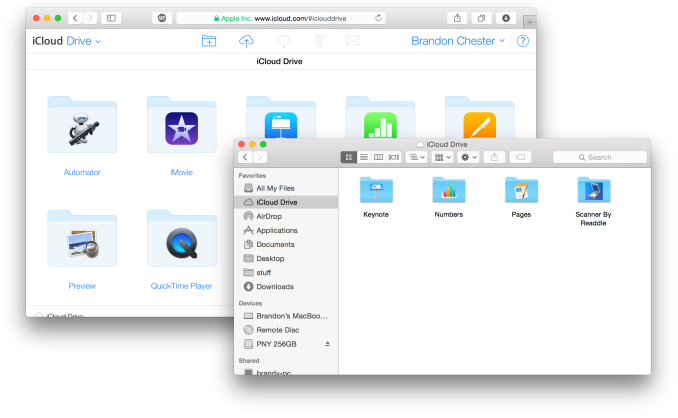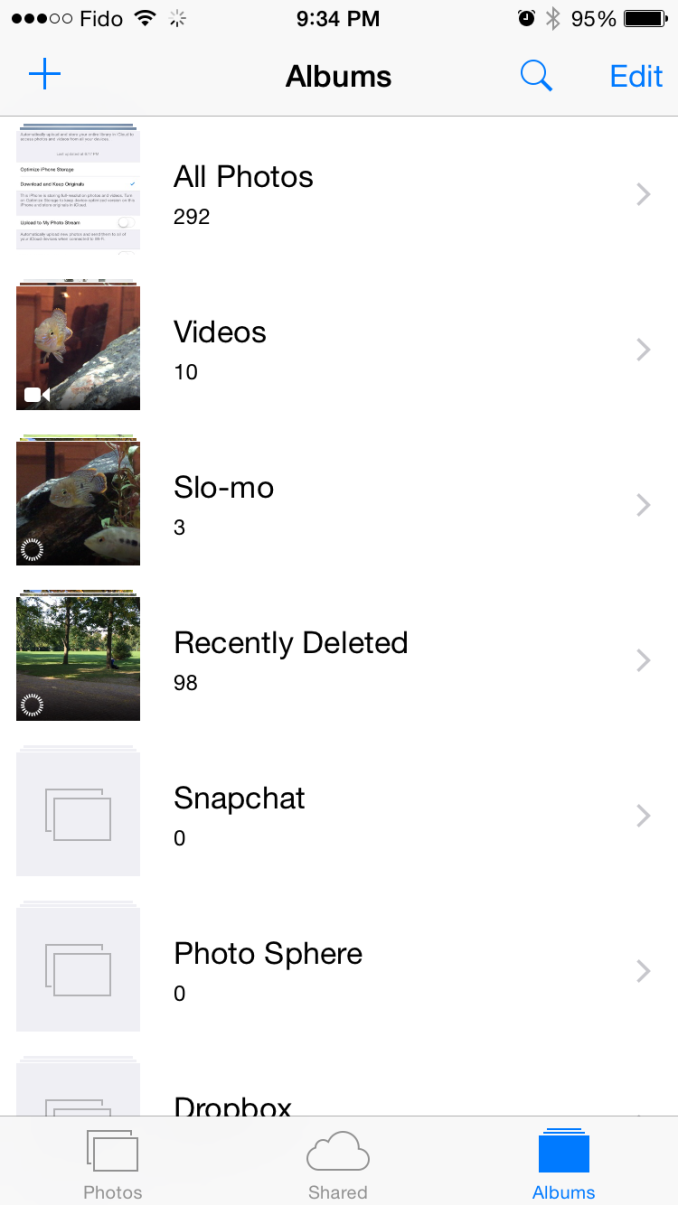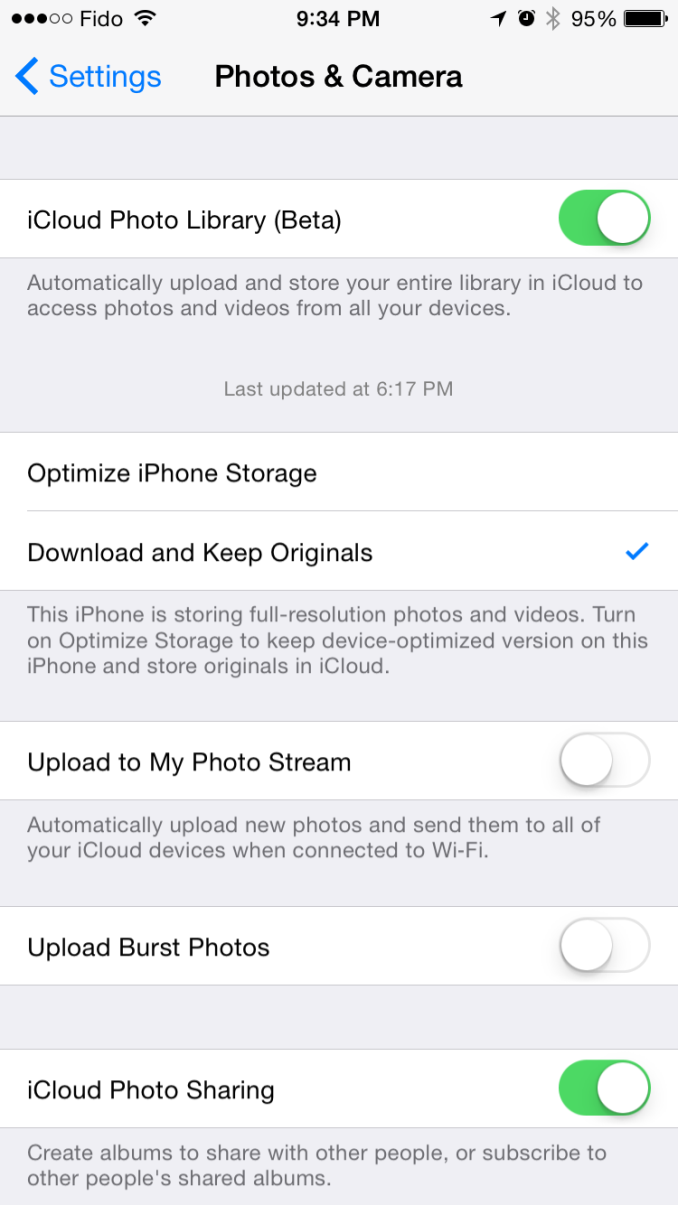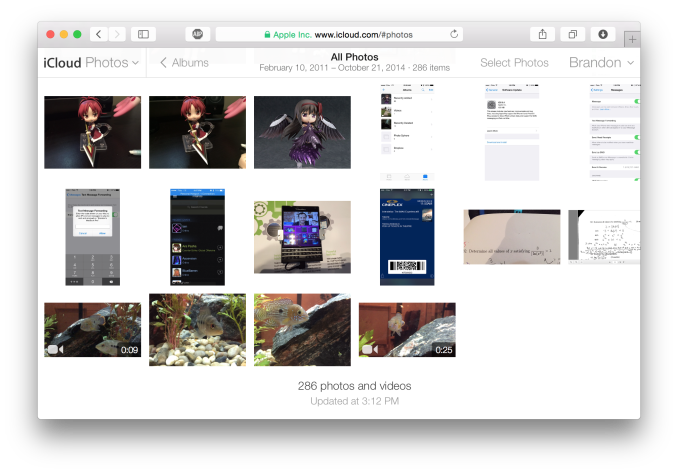A Look At OS X Yosemite And iOS 8.1
by Brandon Chester on October 27, 2014 8:00 AM ESTiCloud Drive and Photo Library
At WWDC 2014 Apple introduced a number of significant additions and improvements to their iCloud service for developers and consumers. On the user side we got iCloud Drive and iCloud Photos. Both of these features position themselves against the offerings from other companies in the increasingly competitive cloud storage space. Apple's advantage within their own ecosystem is how iCloud integrates with their own systems better than Dropbox, OneDrive, or Google Drive ever can. Integration cannot keep a service alive if it becomes stagnant though, and these two features are very necessary additions.
iCloud Drive
iCloud Drive is arguably the more important and interesting of the two features. In the past, iCloud has been something like a magic black box that users can never access or even look into. Files would be created in an application, sent to iCloud, and hopefully they would show up on your other devices. This type of model makes for a great document synchronizing solution, but it's not very good at some of the other things people have grown to expect from a cloud storage service. Apple had to build something that allowed users to manage their documents stored in iCloud, including the ability to add or remove files as needed without having to go into each individual iCloud enabled application.
As a file storage service, iCloud Drive functions exactly how you would expect. You can make folders, and upload files to those folders which can be accessed on any other device with access to iCloud drive. In addition to those files, iCloud Drive also houses the files for any iCloud enabled application. As you can see above, each iWork and iLife application also has its files accessible in iCloud Drive, along with third party iCloud enabled apps like Scanner by Readdle.
Your drive can be accessed in a few different ways. In OS X it's integrated right into Finder and is listed in Favorites by default. Windows users can download Apple's iCloud Control Panel to have it accessible via Windows Explorer. I've avoided the Windows solution because my past experience is that having iCloud Control Panel do anything with to Windows Explorer will make it crash Windows Explorer. While I haven't experienced that while using the new Control Panel 4.0 for the purposes of this review, I still don't trust it.
The third method is to access it from iCloud.com. You would think that with these 3 options, including a web based option, Apple would have every platform covered. Unfortunately they don't. There is no way to directly manage iCloud Drive from an iOS device because iCloud.com displays a special page with links to get information on setting up iCloud and installing Find my iPhone. Applications that integrate with iCloud have the ability to open documents stored in iCloud Drive using the document picker, but there's no way to move or delete other files. I don't know if this is just an oversight or if Apple doesn't want it accessible via mobile but it is honestly a necessary feature and I hope to see it added soon either through an app or through iCloud.com on iOS.
iCloud Photos
iCloud Photo Library was released with iOS 8.1 in the form of a public beta. I actually wrote about it in my initial iOS 8 review due to confusion regarding its availability. It was only near the end of Apple's beta cycle that they revealed SMS Forwarding and iCloud Photo Library would be arriving with a later release. On top of that, using the OS X Yosemite preview would cause the option to reveal itself on your iOS devices. As a result, my devices running the gold master build still had the feature and I was unaware that for most users it would not be accessible until October. But now October has come and we can take a closer look at iCloud Photo Library in its beta form. Users who want to try it out just need to opt into the beta in the Photos & Camera section of the Settings application. Doing so will change the name of Camera Roll to All Photos in the Photos app.
As I've stated before, iCloud Photo Library is not the same as Photo Stream. Photo Stream is really just a method of pushing your photos between all your devices. It relies entirely on local storage and the photos are removed from iCloud after 30 days. iCloud Photo Library keeps all of your pictures in the cloud, and keeps the most recent and frequently accessed ones locally on your device. This is often referred to as nearline storage. Users can also specify to download copies that are optimized for their display resolution which will save space compared to storing full resolution copies on local storage.
iCloud Photo Library is definitely a great feature, but right now the experience is missing a few key things. On iOS it works very well due to how the entire photo experience is within the Photos application. On OS X it's still lacking. Some people may feel it's unfair to criticize certain aspects due to the fact that the feature is technically a beta, but oversights need to be addressed for them to be fixed.
The biggest issue for me is that Apple's Photos application for OS X won't be shipping until early 2015. That's quite a long time after the initial release of Yosemite, and an even longer time after iOS 8 was released. This means that there is currently no way to access photos stored in iCloud on a Mac unless it is done through the web interface. It's an okay solution for now, but the web interface is nothing spectacular. It's essentially the iPad Photos app interface but in a web browser. My biggest issue with it is that it doesn't actually scale. The Safari window with iCloud Photos above is as small as you can make the window without introducing horizontal scrolling. Making the window larger doesn't show more photos on the screen, it just makes the thumbnails bigger. This contrasts with iCloud Drive's web interface which does scale the arrangement of folders based on the size and shape of the window.
There is definitely a lot of pressure involved in trying to ship two major operating system updates around the same time every year, and to pack in new features that work across both of them. Apple made it clear at WWDC 2014 that Photos on OS X wasn't going to be ready until 2015, but I think the issue created by that could have been addressed much better by updating iPhoto to support iCloud Photo Library rather than relying on the web interface.














173 Comments
View All Comments
piroroadkill - Monday, October 27, 2014 - link
Call and SMS handoff to other devices! Woah, we're going back in time to Palm Pre. Still a pretty solid set of ideas around that device...ppi - Tuesday, October 28, 2014 - link
I have SMS synced with my Outlook for a year already (and nobody knows how long our IT witheld that one)Call handoff ... I am not sure I would want it, but as optional feature, why not.
CharonPDX - Monday, October 27, 2014 - link
Continuity looks great!Too bad everyone in my house has one side of the equation too old.
I have an iPhone 5C (good!) with an old 2008 iMac (nope.)
My daughter has an iPad Air (good!) and an iPhone 4 (nope, not even iOS 8,) with a 2008 MacBook Pro (nope.)
My wife has an iPhone 4S (nope - just "call on your Mac",) and a brand new MacBook Air (good!)
So the only person in my family that can make *ANY* use of Continuity/Handoff is my wife, and then only for "call on your Mac" - AKA " Use your Mac as a bluetooth Speakerphone.)
Highhbrid - Tuesday, October 28, 2014 - link
There seems to be a lot of talk about soldered RAM in Mac products. The main reason why you can't upgrade RAM in phones is because the form factor would not be nearly as thin and it wouldn't exactly be an SoC anymore.. form factor is crucial to a handheld device. You have to consider things holistically if you're going to try and compare different fruit here. Very seldom do I observe this amongst convo.I think that with a Macbook Air there is legitimate reasoning for soldering the RAM in place. You and Apple want that device as thin as possible. The thinner you can get it, the lighter too.
With Macbook Pros the argument is a lot weaker. Until those bitches get razer thin (which we're an iteration or two from) removable RAM is easy to pull off. Under a generous, PRIVATE Apple, I believe that they would throw that in.
However when you consider the demographic of Macbook Pro purchasers, it's quite an easy money grab for Apple.
"Higher reliability, better performance, and a more compact design" some will say.
Reliable is in, I put the RAM in wrong? Very rarely do I reset someone's RAM to fix there problem.
Performance: I've seen how fast 16GB @ 2133 MHz goes. I'm not buying it.
Compactness? Refer to the above.
Soldered RAM in a Mac Mini? lol Apple
solipsism - Tuesday, October 28, 2014 - link
You didn't make a valid argument to support your comments that the MBP isn't think enough at this point, you just said it would have to be "razor thin" and eluded to the MBA being thinner.How much space is available right now for removable RAM when you consider the size of the sticks, the channel they sit it, how much much further it will sit below the main board, will that interfere with the bottom casing if it's pressed upon in that area, and will there be enough room for thermals.
I suppose it's possible they could have, but it does come with a cost, which you didn't address at all except to say there is zero benefit.
Highhbrid - Tuesday, October 28, 2014 - link
It's inevitable that they will get thinner. How thin? Who knows. But apparently thin is a big deal to Apple, that was their opening feature to the Air 2 announcement. We will see.I think that the first MBPr could have physically included removable RAM, even if it has to be 1mm thicker. Ultimately, that's Apple decision and they could have included it, I feel.
I didn't say anything about the MBA except that there is a valid reason for soldering the memory into place. The MBP are thin enough IMO
blackcrayon - Tuesday, October 28, 2014 - link
Soldered RAM alone doesn't mean anything. The real issue is that the device will cost more up front. If you won't/can't pay more just buy something else.KoolAidMan1 - Wednesday, October 29, 2014 - link
Soldered RAM on the Mac Mini is terrible. It makes sense if they made it REALLY small like an AppleTV but its the same chassis as before.There's an excuse with the MBA and MBP. This is just stupid.
jaymond - Tuesday, October 28, 2014 - link
When will One Drive or Google Drive copycat the photo features of iCloud Drive? I'm a One Drive user and would love this feature. I'm not willing to pay Apple's prices for cloud storage when I have 1TB free with One Drive with Office 360, but I would like to get my photos off my HDD on my Macbook Air.RichieTech - Wednesday, October 29, 2014 - link
The iMac starts at $2500..... starts! And yet no touchscreen! That's the most asinine thing I've ever heard. I'm sure it looks gorgeous but for that price it should do more and so should the previous models for that matter.The iPad can't form its own network, cant have multiple user accounts and doesn't have its own file structure and cost between $500 to $800.... pffffttt !!! I just spit my beer all over my desk :/
I don't see anything different about OS X(
Thanks iCloud for pics of Scarlett Joe... I'm sure you'll keep my credit card safe with Apple Pay?!
You fear after 13 years, you should be glad after 13 years your moving on!
Nope